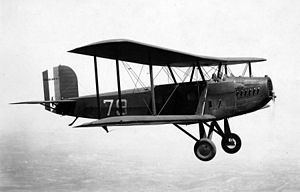Top speed 187 km/h Length 11 m | Wingspan 17 m First flight May 2, 1925 | |
 | ||
Military air transport service mats douglas c 133a historic film 46454
The Douglas C-1 was a cargo/transport aircraft produced by the Douglas Aircraft Corporation for the United States Army Air Service starting in 1925.
Contents
- Military air transport service mats douglas c 133a historic film 46454
- Design and development
- Operational history
- Variants
- Operators
- Specifications Douglas C 1
- References
Design and development
Douglas received an order for nine single-engined transport aircraft in 1925, the first aircraft flying from Douglas's Santa Monica, California factory on 2 May 1925. The C-1 was the first aircraft assigned in the new C- category. The aircraft design was based on several earlier and similar designs developed by Douglas in the early 1920s (including the Douglas World Cruisers used in the first round-the-world flight in 1924). The C-1 featured an enclosed passenger compartment capable of carrying six passengers or about 2,500 lb (1,100 kg) of cargo. A trap door was placed in the lower fuselage to allow large and/or heavy cargo (particularly aircraft engines) to be lifted directly into the cargo compartment. An auxiliary door for passengers and light cargo was included on the right side of the center fuselage.
Operational history
The C-1 biplane was powered by the Liberty L-12 engine and carried a crew of two in an open-cockpit. A C-1 was flown in the 1926 Ford National Reliability Air Tour.
Seventeen additional aircraft were ordered in 1926 and 1927 for the United States Army Air Corps as C-1Cs and were slightly larger than the original C-1s.
Several C-1s were used in test programs—as an engine testbed, as a prototype air ambulance and as refueling aircraft for early air-to-air refueling experiments. Two of these aircraft were used as "tankers" in the 1929 record endurance flight of the Fokker C-2 Question Mark.
Variants
Operators
Specifications (Douglas C-1)
Data from McDonnell Douglas Aircraft since 1920
General characteristics
Performance
